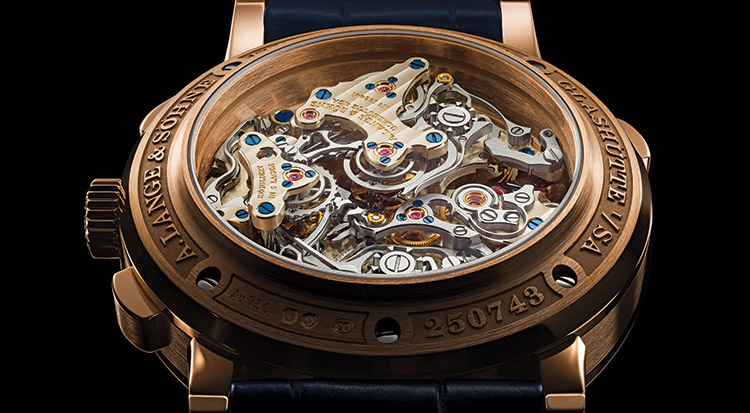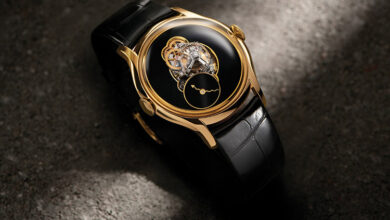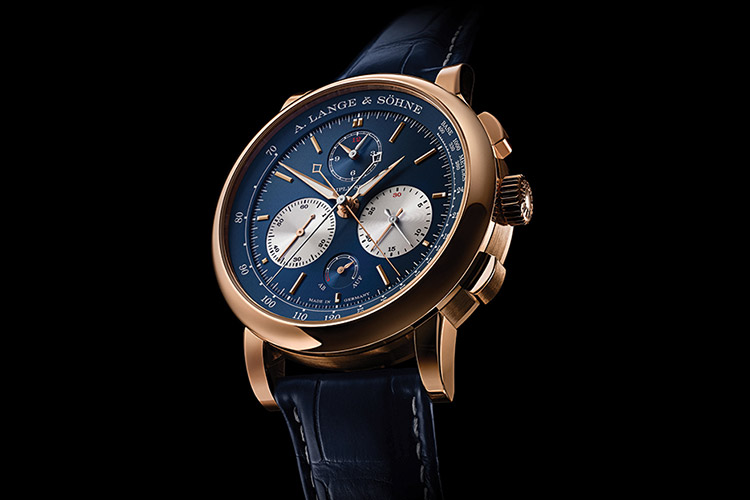
Lange & Söhne crafts only a few thousand wristwatches per year, predominantly in gold or platinum, endowed exclusively with proprietary movements that are lavishly decorated by hand and assembled twice. With 67 manufacture calibres developed since 1990, the marque has secured a top-tier position in the world of watchmaking. This year, the brand has returned with further editions of the Triple Split, Perpetual Calendar and Moonphase
Triple Split
Introduced in 2018, the Triple Split is the world’s only mechanical split-seconds chronograph that allows the measurement of intermediate and reference times for durations of up to twelve hours. This second version – a limited edition of 100 – is in pink gold with a blue dial and rhodié-coloured sub-dials. The Triple Split is a logical evolution of the Double Split introduced by brand in 2004.
Stopping times of up to twelve hours is possible with the Triple Split – a rarity in a mechanical chronograph. The extension of the rattrapante function to the hour counter offers a multitude of further possibilities. For instance, the timepiece can compare the times of two opponents in a Formula One race. It is also possible to stop the times of consecutively starting events or add together the times of multiple-hour events such as the duration of the individual Ironman disciplines. Any number of lap times can be stopped during additive time measurements.
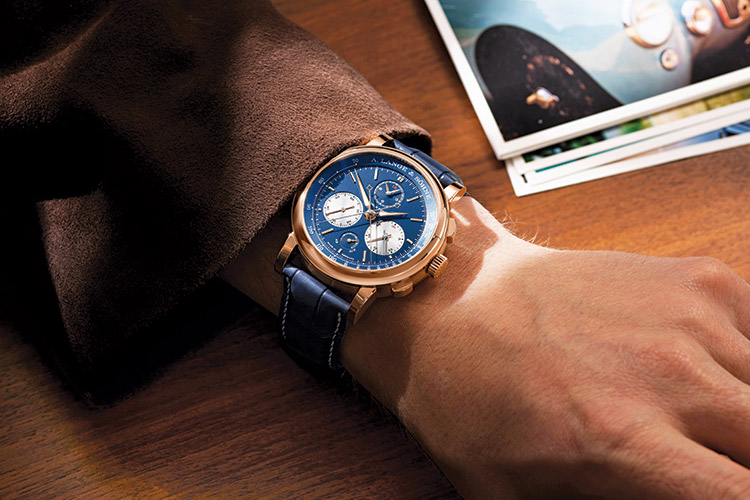
In the starting position, the three rhodiumed rattrapante hands are superposed on the respective chronograph hands. The time measurement is started by pressing the chronograph pusher at 2 o’clock. The pairs of hands now run synchronously until they are separated by pressing the rattrapante pusher at 10 o’clock to perform a lap-time measurement. The three rhodiumed hands will then stop to display the lap time. All the while, the previously concealed chronograph hands in gold-plated steel or pink gold continue the time measurement. As soon as the rattrapante pusher is pressed again, the rattrapante hands catch up with the chronograph hands and from then on run together with them again. The movement is also endowed with a flyback function that involves all three hand pairs as well. Thus, the chronograph can be reset to zero by pressing the chronograph pusher at 4 o’clock during an ongoing time measurement. Releasing the pusher instantly starts a new time measurement.
The Lange Calibre L132.1 has 567 tiny parts perfectly adjusted for flawless interaction. The creation of a mechanism to collectively or separately control three hand pairs represented a formidable technical challenge. Even a simple rattrapante mechanism has two hands attached to arbors that run one inside the other. In the calibre L132.1, this pairing exists three times. During the assembly of the movement, the multiple-function axes call for the utmost precision and virtuosity. A glance through the sapphire-crystal caseback reveals the beautifully finished chronograph movement that assures the perfect interaction of column wheels, clutches, rockers, levers, springs, and jumpers. Five gold chatons, traditionally secured with screws on bridges decorated with Glashütte ribbing as well as the hand-engraved balance cock round off the stylish prominence of the movement.
Lange 1 Perpetual Calendar
The new Lange 1 Perpetual Calendar is totally focused on the eponymous complication. Its integration into the prominent dial layout of the Lange 1 was made possible thanks to a peripheral month ring created especially for this design. The new timepiece comes in pink gold with a grey-silver dial or – a limited edition of 150 – in white gold with a solid pink-gold dial. The moon-phase display with an integrated day/night indicator is a further special feature. To integrate the calendar ensemble into the exceptional off-centre dial architecture of the Lange 1 without compromising the harmonious balance of the displays, the month indication was implemented with a ring – that advances once a month – at the periphery of the dial. This design replaces the classic control principle with a 48-step cam. The innovation challenged the ingenuity of Lange’s engineers because advancing the ring at the end of the month requires considerably more power than traditional solutions.
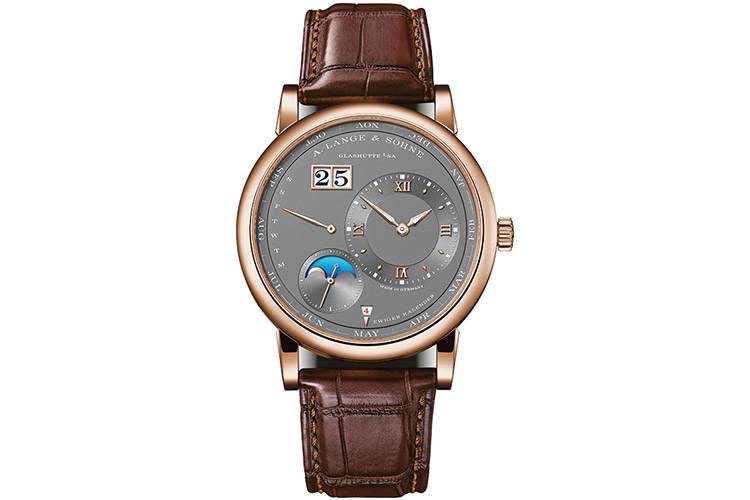
The ring-shaped month display is complemented with the Lange outsize date, a retrograde day-of-week display, and a leap-year indication. The instantaneously advancing calendar displays are always crisply legible, and can be advanced collectively or individually with correctors. Once properly set, the mechanism is programmed to reliably indicate each month change until the year 2100. The watch additionally features a moon-phase display with an integrated day/night indicator.
The combination of the moon-phase display with a day/night indicator has two layers. It consists of a solid-gold celestial disc with a blue gradation. It completes one full revolution about its own axis every 24 hours. Against this background, the moon – either in white or pink gold – performs its synodic orbit in 29 days, 12 hours, 44 minutes, and three seconds with such precision that it takes 122.6 years before a correction by one day is needed. The moon appears on a monochrome light blue canopy during the day and on a dark blue starry sky at night.
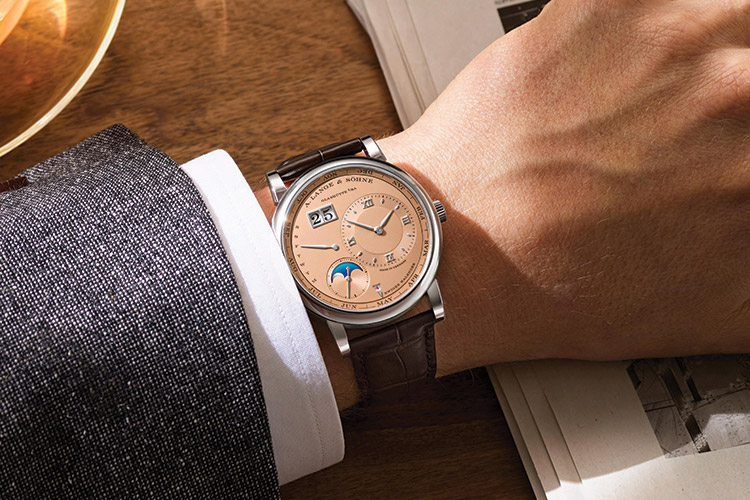
The self-winding movement L021.3 is A. Lange & Söhne’s 67th manufacture calibre. Based on the calibre L021.1 of the Lange 1 Daymatic, it has been endowed with a newly developed winding mechanism. Its technical features include a unidirectional winding rotor in 21-carat gold with an additional centrifugal mass in platinum, a power reserve of 50 hours, and a cam-poised balance that runs with a frequency of 21,600 semi-oscillations per hour.
Little Lange 1 Moon Phase
Thousands of tiny stars seem to sparkle on the dark-blue dial of the Little Lange 1 Moon Phase in its white-gold case. It is coated with dark-blue gold flux that shimmers with a copper hue. A white-gold moon accurately orbits along its course beneath the iconic Lange outsize date. In a second version, a bezel set with 56 brilliant-cut diamonds creates a radiant frame for the fascinating dial. The fascination of a bright moonlit night is the motif of the new Little Lange 1 Moon Phase. Its eye-catcher is the solid-silver dial coated with shimmering dark-blue gold flux; the sparkling copper particles evoke a starry nocturnal sky. The applied Roman numerals at 3, 6, 9, and 12 o’clock as well as the star-shaped hour markers between them are crafted from rhodiumed gold just like the hands. The dark hue of the dial is echoed by the outsize date and the white-gold lunar disc with its 628 stars. A dark-blue, shiny leather strap with sparkling pigments and a solid white-gold buckle complement the elegant appearance of the watch. In the second version, 56 brilliant-cut diamonds adorn the bezel of the white-gold case with a diameter of 36.8 millimetres.
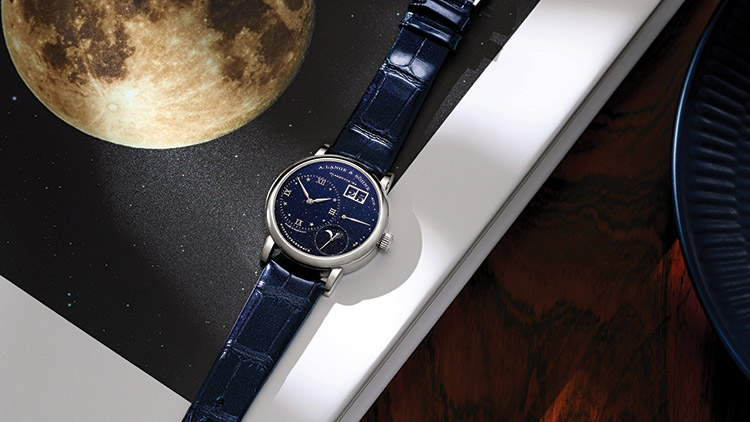
The moon-phase display is calculated to remain accurate for 122.6 years. More realistically, a correction might be necessary occasionally if the watch remains unwound for an extended period of time. The corrector between 7 and 8 o’clock allows the display to be updated quickly and easily. A corrector that is also recessed in the case between 10 and 11 o’clock advances the outsize date day by day. With an off-centre dial layout, outsize date, power-reserve indicator, the twin mainspring barrel, and a three-day movement, the Little Lange 1 Moon Phase has all of the technical features of the Lange 1.
